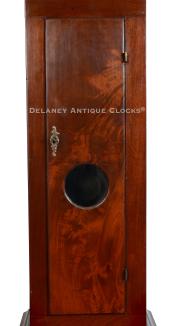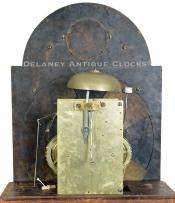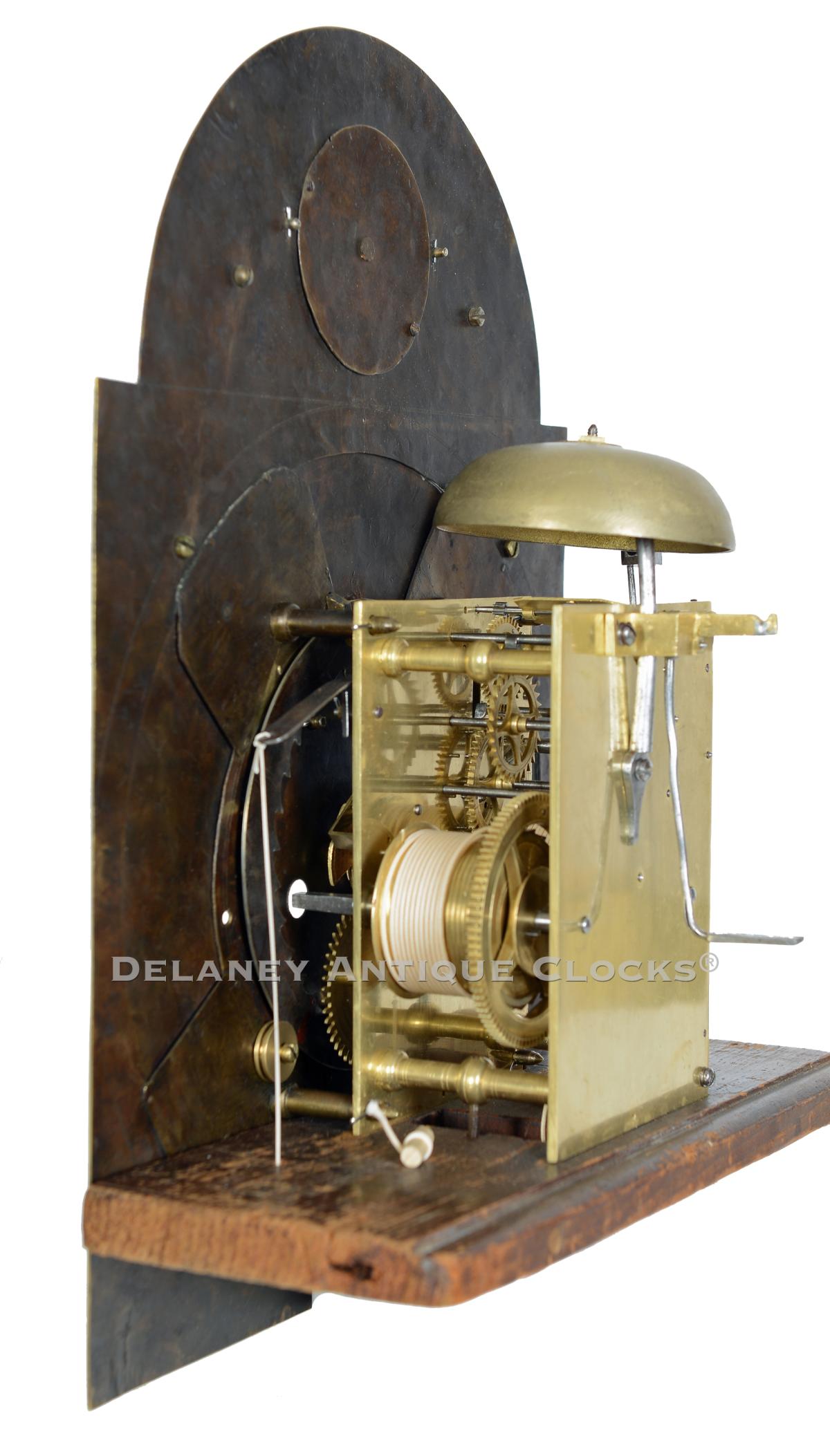Samuel Rockwell of Providence, Rhode Island. This is an early American-made tall case clock of a diminutive stature. 223324.
This is an important mahogany-cased tall clock made by Samuel Rockwell of Providence, Rhode Island, circa 1747. Rockwell was an early Providence clockmaker. Very few American Pre-Revolutionary clocks were made in this country, and fewer survived. This fine early Rhode Island example is one of the ten signed examples currently known. Of the ten, three other signed Rockwell clocks feature a similar dial engraving that is complex and embellished with florals. The first is at Brown University in the Office of the Dean of College. The second example is privately owned but is pictured in Frank Holman's important book, Timeless, Masterpiece American Brass Dial Clocks. The third example is pictured in Chris Bailey's Two Hundred Years of American Clocks and Watches.
This Queen Anne mahogany case form exhibits excellent selections of wood that feature an attractive grain pattern. The classic shellac finish enhances the pattern. An applied base molding rests flat on the floor. The waist section is long and centers a rectangular-shaped waist door. This door is trimmed along its perimeter with a simple molded edge. The hinged door opens to allow one access to the case's interior. One will find the two drive weights and the brass-faced pendulum bob inside the case. The waist door features a circular cutout fitted with glass—the pendulum bob swings behind this in the back of the case. The bonnet features a flat cornice top. This style of bonnet is also an early form. This design feature is positioned above a molded arch that conforms to the shape of the dial door and the dial. The two colonettes visually support the molded arch and are applied to the hood door. These are smoothly turned and feature wooden capitals. Two additional quarter columns are mounted at the back corners of the hood. The sidelights are also a tombstone shape and fitted with glass. The bonnet door is arched in form and opens to access the composite brass dial.
This style of dial predates the painted dial form. It is composed of a brass sheet and is decorated with several decorative elements—a herringbone band of engraving frames the dial shape. Four cast corner spandrels frame the applied time ring. These are designed with a woman's head and headdress surrounded by flowers. Two additional dolphin spandrels are in the arch, centering a circular engraved detail that includes an applied ring and compass star centering a Tudor rose. The Tudor rose is often used to symbolize the English monarchy, the heraldic emblem of William and Mary's reign. The time or chapter ring is engraved with Arabic-style five-minute markers and quarter-hour Fleur-de-lis markers separated from the Roman-style hour numerals and Fleur-de-lis half-hour markers by a closed minute ring. Inside this ring, the dial surface has been textured or matted so that one can locate the hands of the clock more easily. This area is also wonderfully engraved with floral patterns. Engraved circles are positioned at each five-minute position. The two openings for the winding arbors are ring-turned. The hands are filed steel and display the time. "Samuel Rockwell" is engraved on the arched band. One will also find a display for the calendar day and a subsidiary seconds dial in this location.
The two-train movement is brass, has an eight-day duration, and is good quality. Five ring-turned pillars or posts secure the two large brass plates. Hardened steel shafts support the polished steel pinions, brass gearing, and recoil escapement. The winding drums are grooved. The weight-driven movement is intended to run for eight days on a full wind. It features a rack and snail striking system. As a result, it will strike each hour on the hour on a cast iron bell mounted above the movement.
Samuel Rockwell made this clock in Providence, Rhode Island, circa 1747, before he moved to Hampton, Virginia, in 1752. The case stands approximately 75 inches tall to the top of the cornice molding, 18.5 inches wide, and 10.25 inches deep.
Inventory number 223324.
Samuel Rockwell was born on October 13, 1722, in Middletown, Connecticut. His parents were Joseph (1697-1757) and Savanna (Yeomans) Rockwell, who married in Middletown on December 21, 1721. Samuel is thought to have trained as a clockmaker in Providence, Rhode Island. His training would have started about 1735, and he would have become a journeyman clockmaker by 1742. Samuel worked in Providence until 1752. A tall clock is known signed with the place location of Providence. In 1752, he moved to Hampton, Virginia, making him the first clockmaker known in the Virginia colony. He advertised in October of 1752 in the Virginia Gazette that he made, sold, and cleaned clocks and watches in his shop in Hampton. He also had clocks for sale in Mr. Finnie's shop in Williamsburg. Samuel worked here until 1755. During this time, he also began trading goods such as coffee, sugar, and molasses in New York City. He also owned a sloop of 60 tons. In 1752, he moved to Philadelphia, PA. In 1762, he moved back to Middletown, Conn. In 1763, he married Abigail Goodwin Johnson, the widow of Daniel Johnson. Samuel died in Middletown in 1773, insolvent.





















